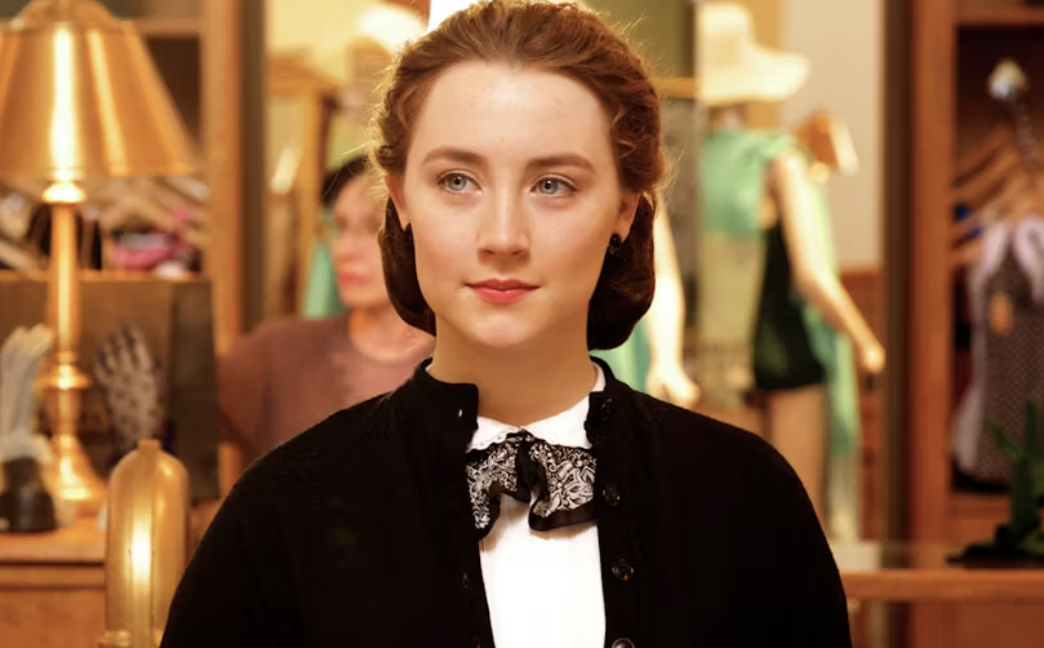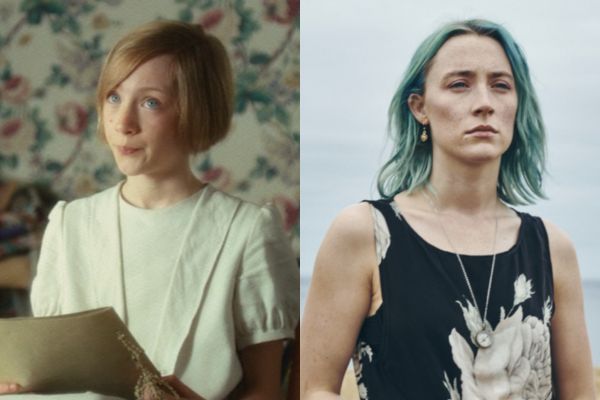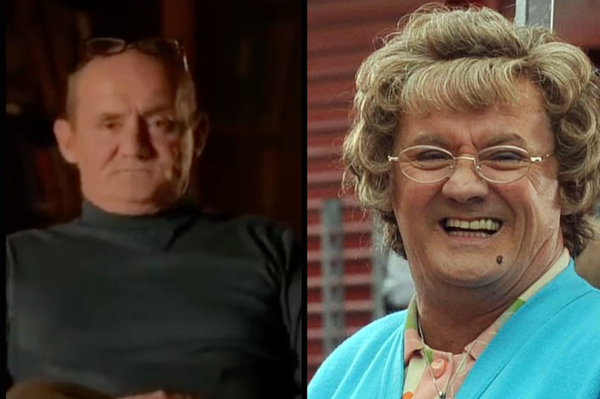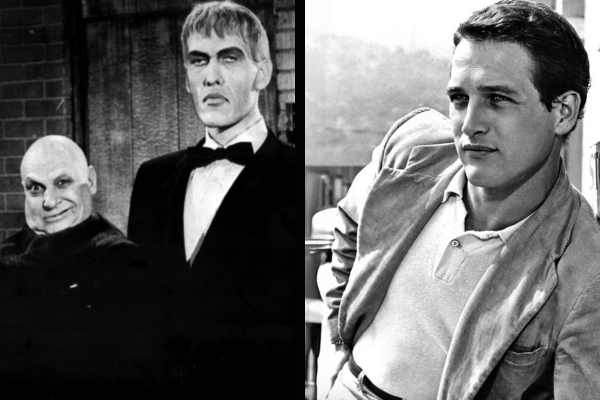Few actors can embody the versatility of Saoirse Ronan. Born in the Bronx, raised in Carlow and Howth, she brings something intangible and nuanced to every role. In this article, author Aubrey Malone explores the spectacular craft and career of one of Ireland's best creatives.
“They still can’t get my name right in America,” says Saoirse Ronan bemusedly. This is evident as Conan O’Brien made a dog’s dinner of it a year or so ago on The Late Late Show – and he’s supposed to be Irish. Well, sort of. And Saoirse was born in America. Maybe one of these years Conan - and his stateside friends - will finally realise it’s not Shoorshey, Sorka, Sarshe, Sheesha (thank you, Dennis Quaid). Let alone any of the other tortuous manifestations trotted out on U.S. TV. Ellen DeGeneres once made a sign for her to wear around her neck saying, “Hello, my name is Sur-Sha” but even she got it wrong. It should have said, “Hello, my name is Seer-Sha.”
Though still in her early thirties, Saoirse is Ireland’s Meryl Streep, and just as good with accents. She’s head and shoulders above her Hollywood peers. Every time she appears in a role she brings something new and unexpected to it: a speech pattern, a walk, an insight into her character born both of research and intuition, a credibility that comes from such immersion. She all but becomes the character. And they her. On the surface, it's effortless.
We’ve grown to expect nothing but the best from Saoirse since she first appeared on our screens before even graduating Primary School. One feels sure she’ll never sell out that original conviction, looking for the key to every part in her technical approach to acting. She even brings something to the silly roles she does every now and then (The Grand Budapest Hotel, anyone?) to fill a gap. Recently married, she’s drawn much praise for her latest performances in The Outrun and Blitz.
In the latter she plays her first major maternal role. It sees her frantically searching for her lost son during World War II in London. She also sings in it. In The Outrun she’s a recovering alcoholic, being in every scene in the film and playing them all with subdued perfection.
Saoirse’s husband is the Scottish actor Jack Lowden. They met on the set of Mary Queen of Scots in 2018. She took her part as Mary, Queen of Scots seriously. Refusing to socialise with her co-star Margot Robbie (Elizabeth I), Saoirse and Margo kept their distance on set as their roles required them to be at loggerheads in the film.
She’s been Jack’s partner since that film, but they’ve only recently tied the knot. He is rumoured to have proposed to her on a hiking trip towards the end of 2023 (According to a cryptic instagram post). They married in secret in Edinburgh the next year, inviting only a handful of friends to the ceremony.
Behind the Scenes
In fact, Saoirse does most things in secret when she’s not facing the camera lens. Even when she goes a bit wild on a night out, she makes sure it’s when she’s far from the limelight. That’s what you have to do when you’ve been such a high-profile person as this lady has since her early teens. And when you love the “craic,” like she obviously does.
Her parents, Paul and Monica, fled Ireland for America in the 1980s when employment was hard to come by here. Paul got a job as a construction worker, doing acting in his spare time but finding it tough to land parts. Monica was a nanny. They lived in a poky apartment in the Bronx as illegal immigrants.
Saoirse was born in the Bronx on 12th April 1994. Three years later, as the Celtic Tiger began to roar in earnest, they returned to Ireland and bought a house in Carlow. They later moved to Howth, which explains how Saoirse speaks with a Dublin accent rather than a country one.

She made her screen debut in the RTÉ series The Clinic in 2003. Four years later she auditioned for the part of Luna Lovegood in Harry Potter and the Order of the Phoenix. Half the country appeared to be in the running for this, so Saoirse knew it was going to be a long shot. She was unsuccessful in her bid, losing out to another Irish actress, Evanna Lynch.
In the same year, however, she appeared in the film that made her name, winning an Oscar nomination for her keenly judged performance in. Atonement was Joe Wright’s adaptation of Ian McEwan’s highly acclaimed novel. Her character Briony was an aspiring writer and a spiteful young girl who saw a lot of things she shouldn’t have and misinterpreted many of them.
Critics and audiences alike were astounded by Saoirse's maturity in front of the camera. A bright future was predicted for her. Her mother had experience on the other - less pleasant side - of the business from watching Paul struggling to earn a crust treading the boards. So Monica wasn’t taking anything for granted when it came to her daughter. She knew success wasn’t always about talent. Paul was a fine actor, but he never broke to anywhere near this level of success.
Saoirse gave another strong performance in Peter Jackson’s The Lovely Bones in 2009 as Susie, a fourteen-year-old girl, who’s killed by her neighbour. Susie relates details from behind the grave, and this film set the tone for a cavalcade of esoteric roles. And while the Lovely Bones did not lose money at the box office, it remains known as a creative disappointment in the industry.
Two years later, Hanna followed suit. This unusual film had Saoirse playing a 15-year-old assassin raised in the Arctic wilderness. She spent months practising martial arts preparing for it, which meant she did all her own stunts. Once again, however, despite critical praise this time, Hanna also failed to take off at the box office.
Then Byzantium, the gothic horror film directed by Neil Jordan, was the same. Saoirse always wanted to work with him. She played a 200-year-old vampire in yet another display of her chameleon-like qualities.
2013 saw her in How I Live Now, a dystopian tale where she was an American teenager living on a farm on the cusp of World War III. In 2014 she appeared in the aforementioned Wes Anderson vehicle, The Grand Budapest Hotel. It had a lot of cult appeal, but her role was small and didn’t capture as many headlines as she might have wished.
Strategy on Screen
Was she going to be another one of those promising child stars who failed to make it as a grown-up? Actresses who successfully straddled both demographics (Judy Garland, Natalie Wood, Elizabeth Taylor) were in the minority. Most other child stars, like Shirley Temple and Deanna Durbin, had chequered adult careers or none at all. Would Saoirse, like those forgotten neophytes, lay suspended in a kind of celluloid limbo as an “in-betweener?” Was she too old to be cute and too young for rite-of-passage roles?
She was determined to avoid that pitfall. Significantly, The Grand Budapest Hotel was the first film she made without her parents being with her on set. Perhaps that was the secret. She had to shed the apron strings offscreen before she could do so on it.
It seemed to be a statement. She was ready to break out on her own. She moved to a flat in London.
Saoirse made her Broadway debut, appearing in Arthur Miller’s The Crucible, again wowing audiences with her precociousness. She brought the same visceral energy to the stage as she’d already done to the screen, time and again.
She dispelled people’s fears about her ability to make a successful film as an adult when she landed a much-coveted role in John Crowley’s adaptation of Colm Tóibín’s Man Booker Prize-nominated novel Brooklyn. This had her as a lonely Irish girl trying to find her feet in 1950s New York so she could overcome the nostalgia she felt for her native Enniscorthy.

Diaspora was a subject that struck a chord with her from her parents’ experience. “This is really my parents’ story,” she suggested. She is captivating in the film, embodying all the pain of exile as she chose between lovers on both sides of the Atlantic. It was her breakthrough role and resulted in a second Oscar nomination.
Two years later she got a third nomination for playing a rebellious role in Greta Gerwig’s highly acclaimed Ladybird. By this time, she was getting more comfortable headlining box office hits.
In Ladybird she played the titular character, a senior in high school who’s constantly arguing with her mother. Nothing could have been more different from real life. Saoirse has a huge bond with Monica. “We know it’s gold dust what we have,” she says, “We hit the jackpot with each other.”
Another two years on from Ladybird the Hollywood Academy conferred her with her next Oscar nod for a new film based on Louisa May Alcott’s Little Women.
That meant four nominations altogether…but no actual award. She pocketed a Golden Globe for Ladybird as well as nominations for a BAFTA and a SAG (Screen Actors Guild) award but, like her Oscar nomination, none of the latter two resulted in a win. People now started asking a new question about Saoirse. It wasn’t, “Will she make it as an adult?” but rather, “When is she going to win that elusive Oscar?”
This sees Saoirse share a category with Glenn Close or Amy Adams, accomplished actors who kept getting shortlisted by the Academy but never being invited into the winner’s enclosure.
Saoirse waved away questions from reporters on this score, putting thoughts of trophies out of her mind as she busied herself with getting into the heart and soul of the characters she played. She also devotes her time to many worthy causes, becoming an advocate for the Irish Society for the Prevention of Cruelty to Children and lending her name to Home Sweet Home, a campaign to combat homelessness.
Look to the Future
Will Saoirse finally break her Oscar luck soon? At thirty-one, she’s the second youngest actress in Hollywood history to have clocked up six nominations. We were all expecting her to be nominated for The Outrun...but alas this wasn't to be.
The Outrun was co-produced by both Saoirse and Jack through their company Arcade. Jack set it up in 2019, Saoirse joining it two years later. They have both now left it.
The subject of alcoholism is close to her heart. Like most Irish people, if not people the world over, she’s been acquainted with people who suffered from it. She was also very taken with Amy Liptrot’s book on which it was based. Her husband Jack recommended it to her, saying, “This is your next movie.” He read it during Covid, when, as Saoirse says, “We were all reading three books a week.”
He loved it for its honesty. This is something Saoirse brought to the role in spades, taking her character on a cathartic odyssey from rehab to the Orkney Islands before reaching a tenuous peace with herself.
Jack recently described Saoirse as “a force of nature.” He compared her to a Ferrari, adding, “And you don’t treat a Ferrari like a Renault.”
She was chuffed by his praise. Was it better than getting an Oscar? “An Oscar would also help,” she pointed out. And apparently the pair look forward to producing something very different together very soon...
Aubrey Malone has an MA in English and was a primary school teacher before he then went into journalism, freelancing for publications including the Evening Press, The Cork Examiner and the Sunday Independent. He was the movie critic for Image magazine and for Modern Woman, a supplement to the Meath Chronicle. His latest book Hollywood Wit, is available to buy online here.




